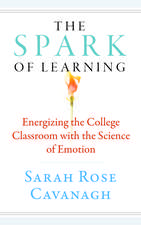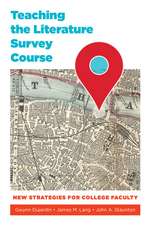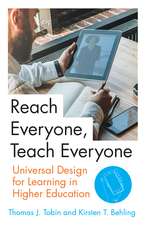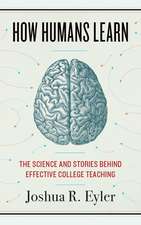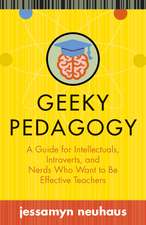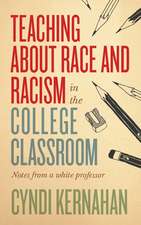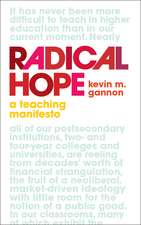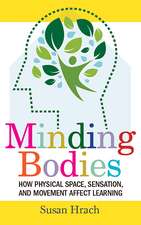Intentional Tech: Principles to Guide the Use of Educational Technology in College Teaching: Teaching and Learning in Higher Education
Autor Derek Bruffen Limba Engleză Paperback – noi 2019
Chalkboards and projectors are familiar tools for most college faculty, but when new technologies become available, instructors aren’t always sure how to integrate them into their teaching in meaningful ways. For faculty interested in supporting student learning, determining what’s possible and what’s useful can be challenging in the changing landscape of technology.
Arguing that teaching and learning goals should drive instructors’ technology use, not the other way around, Intentional Tech explores seven research-based principles for matching technology to pedagogy. Through stories of instructors who creatively and effectively use educational technology, author Derek Bruff approaches technology not by asking “How to?” but by posing a more fundamental question: “Why?”
Arguing that teaching and learning goals should drive instructors’ technology use, not the other way around, Intentional Tech explores seven research-based principles for matching technology to pedagogy. Through stories of instructors who creatively and effectively use educational technology, author Derek Bruff approaches technology not by asking “How to?” but by posing a more fundamental question: “Why?”
| Toate formatele și edițiile | Preț | Express |
|---|---|---|
| Paperback (1) | 159.64 lei 6-8 săpt. | |
| West Virginia University Press – noi 2019 | 159.64 lei 6-8 săpt. | |
| Hardback (1) | 582.96 lei 6-8 săpt. | |
| West Virginia University Press – noi 2019 | 582.96 lei 6-8 săpt. |
Din seria Teaching and Learning in Higher Education
-
 Preț: 148.68 lei
Preț: 148.68 lei -
 Preț: 105.14 lei
Preț: 105.14 lei -
 Preț: 177.58 lei
Preț: 177.58 lei -
 Preț: 239.99 lei
Preț: 239.99 lei -
 Preț: 231.56 lei
Preț: 231.56 lei -
 Preț: 242.68 lei
Preț: 242.68 lei -
 Preț: 178.17 lei
Preț: 178.17 lei -
 Preț: 188.07 lei
Preț: 188.07 lei -
 Preț: 484.26 lei
Preț: 484.26 lei -
 Preț: 179.52 lei
Preț: 179.52 lei -
 Preț: 215.13 lei
Preț: 215.13 lei -
 Preț: 172.82 lei
Preț: 172.82 lei -
 Preț: 159.05 lei
Preț: 159.05 lei -
 Preț: 159.05 lei
Preț: 159.05 lei -
 Preț: 165.42 lei
Preț: 165.42 lei -
 Preț: 214.56 lei
Preț: 214.56 lei -
 Preț: 215.13 lei
Preț: 215.13 lei -
 Preț: 213.08 lei
Preț: 213.08 lei -
 Preț: 218.42 lei
Preț: 218.42 lei -
 Preț: 232.41 lei
Preț: 232.41 lei
Preț: 159.64 lei
Nou
Puncte Express: 239
Preț estimativ în valută:
30.55€ • 31.83$ • 25.29£
30.55€ • 31.83$ • 25.29£
Carte tipărită la comandă
Livrare economică 03-17 aprilie
Preluare comenzi: 021 569.72.76
Specificații
ISBN-13: 9781949199161
ISBN-10: 1949199169
Pagini: 240
Ilustrații: 29
Dimensiuni: 127 x 203 x 18 mm
Greutate: 0.29 kg
Ediția:1st Edition
Editura: West Virginia University Press
Colecția West Virginia University Press
Seria Teaching and Learning in Higher Education
ISBN-10: 1949199169
Pagini: 240
Ilustrații: 29
Dimensiuni: 127 x 203 x 18 mm
Greutate: 0.29 kg
Ediția:1st Edition
Editura: West Virginia University Press
Colecția West Virginia University Press
Seria Teaching and Learning in Higher Education
Recenzii
“Derek Bruff is an engaging—and often charming—guide throughout this concise book. The stories he tells keep things moving at a crisp pace and offer pedagogical inspiration. His principles provide a useful framework and establish a clear foundation for his practical advice.”
Peter Felten, coauthor of The Undergraduate Experience: Focusing Institutions on What Matters Most
Peter Felten, coauthor of The Undergraduate Experience: Focusing Institutions on What Matters Most
Notă biografică
Derek Bruff is the director of the Vanderbilt University Center for Teaching, where he helps faculty and other instructors develop foundational teaching skills and explore new ideas in teaching and learning. He is the author of Teaching with Classroom Response Systems: Creating Active Learning Environments.
Extras
Introduction
What technologies have you used or seen used in teaching contexts? As the director of a teaching center at a research university, I frequently lead workshops on teaching for faculty on my campus and elsewhere. Often, those workshops are focused on teaching with technology, a particular interest of mine. I’ll usually open such a workshop with that question about teaching technologies the participants have used or seen, and ask them to respond via a polling system of some kind, using their phones or laptops to submit lists of technologies. The polling system I use assembles the participants’ responses in a word cloud, where the more popular a response is, the larger the font size.
Course management systems, like Blackboard and Canvas, are usually in big letters, as are platforms not expressly designed for education, like YouTube, Google, and PowerPoint. Since I wrote a book on polling systems, Teaching with Classroom Response Systems, there are usually a number of responses from that category of technology. Other common responses depend on the crowd—scientists tend to mention online homework systems, digital humanists tend to mention Twitter.
Rarely, however, is my favorite educational technology mentioned: wheels on chairs. And by that, I mean classroom furniture, including tables and chairs, that I can easily move around before and during class. When I walk into my classroom, I typically have planned a series of activities for my students focused on my learning objectives for the day. Sometimes that involves whole-class discussion, other times small group work or pair work or a class debate or a jigsaw activity. Moveable furniture helps me create the kind of classroom environment that supports the learning activities I have planned.
And that’s how educational technology should work. Our teaching and learning goals should drive our technology use, not the other way around. As instructors, if we think of ourselves as designers of learning experiences for our students, then we can start to identify technologies and related teaching practices that help to create or enhance those experiences. That is, we should be intentional in how we use technology, looking for ways the technology can support student learning.
Most instructors are comfortable using familiar technologies, like classroom furniture (with or without wheels) and chalkboards and handouts, in intentional ways. When new technologies become available, however, it’s not always obvious how to use those technologies in the service of learning. Digital and online technologies in particular compose a landscape that college and university faculty are still surveying, working to determine what’s possible and what’s useful. As I’ve talked with faculty across the disciplines about the ways they match technology to pedagogy, a few principles have emerged. In this book, I explore seven teaching principles that can inform and inspire our use of educational technology, digital or otherwise.
What are those principles? Here’s a brief preview of the chapters to come:
1. Times for Telling—Giving students a hard problem or challenging experience can help them get ready for learning.
2. Practice and Feedback—To learn new skills, students need to practice applying those skills and receive[SCS2] feedback on that practice.
3. Thin Slices of Learning—The more we understand what and how our students are learning, the more responsive we can be to their learning needs.
4. Knowledge Organizations—Providing students with visual ways to organize their knowledge can help them remember and use that knowledge.
5. Multimodal Assignments—When students work with new material using different kinds of media, they are better able to learn that material.
6. Learning Communities—Structured ways for students to learn from and with each other can enhance the learning experience for all students.
7. Authentic Audiences—Connecting students to authentic audiences for their work can motivate students toward deeper learning.
Each chapter focuses on a different principle, and each principle is illustrated with multiple examples of teaching practice, drawn from a variety of disciplines and institutional settings. In my educational development work over the years, I’ve consulted with hundreds of college and university instructors, and I’ve interviewed dozens more for this book, for my previous book, and for the educational technology podcast I host, Leading Lines. Through these interactions, I’ve collected stories of intentional, creative, and effective use of technology by faculty and other instructors, and I’m excited to share some of my favorite stories in this book. From my work with faculty, I know that hearing the stories of colleagues can often be the best way to get ideas for one’s own teaching. Faculty also like to know that teaching recommendations are based on research, which is why you’ll find citations in each chapter pointing to supporting educational research, as well as further reading about concepts and examples.
My goal is to inspire readers to be more intentional in how they use technology, whether they’ve been asked to use a particular technology by an administrator or they’ve found some shiny new tool they want to try in their classroom or they just want to be more effective at promoting learning and are open to using technology to do so. As a mathematician, I’m drawn to the idea of principles for teaching and learning. Once I’ve accepted these principles as givens, I can experiment with ways to implement them in my teaching through the activities and assignments I plan for my students. My hope is that readers will find these principles relevant and useful, and that the examples in this book will help them see ways they can put them into practice in their teaching. The seven teaching principles explored here are true whether or not we use technology, but they are particularly useful in helping us become more intentional in how we use technologies, old and new, to foster student learning.
What technologies have you used or seen used in teaching contexts? As the director of a teaching center at a research university, I frequently lead workshops on teaching for faculty on my campus and elsewhere. Often, those workshops are focused on teaching with technology, a particular interest of mine. I’ll usually open such a workshop with that question about teaching technologies the participants have used or seen, and ask them to respond via a polling system of some kind, using their phones or laptops to submit lists of technologies. The polling system I use assembles the participants’ responses in a word cloud, where the more popular a response is, the larger the font size.
Course management systems, like Blackboard and Canvas, are usually in big letters, as are platforms not expressly designed for education, like YouTube, Google, and PowerPoint. Since I wrote a book on polling systems, Teaching with Classroom Response Systems, there are usually a number of responses from that category of technology. Other common responses depend on the crowd—scientists tend to mention online homework systems, digital humanists tend to mention Twitter.
Rarely, however, is my favorite educational technology mentioned: wheels on chairs. And by that, I mean classroom furniture, including tables and chairs, that I can easily move around before and during class. When I walk into my classroom, I typically have planned a series of activities for my students focused on my learning objectives for the day. Sometimes that involves whole-class discussion, other times small group work or pair work or a class debate or a jigsaw activity. Moveable furniture helps me create the kind of classroom environment that supports the learning activities I have planned.
And that’s how educational technology should work. Our teaching and learning goals should drive our technology use, not the other way around. As instructors, if we think of ourselves as designers of learning experiences for our students, then we can start to identify technologies and related teaching practices that help to create or enhance those experiences. That is, we should be intentional in how we use technology, looking for ways the technology can support student learning.
Most instructors are comfortable using familiar technologies, like classroom furniture (with or without wheels) and chalkboards and handouts, in intentional ways. When new technologies become available, however, it’s not always obvious how to use those technologies in the service of learning. Digital and online technologies in particular compose a landscape that college and university faculty are still surveying, working to determine what’s possible and what’s useful. As I’ve talked with faculty across the disciplines about the ways they match technology to pedagogy, a few principles have emerged. In this book, I explore seven teaching principles that can inform and inspire our use of educational technology, digital or otherwise.
What are those principles? Here’s a brief preview of the chapters to come:
1. Times for Telling—Giving students a hard problem or challenging experience can help them get ready for learning.
2. Practice and Feedback—To learn new skills, students need to practice applying those skills and receive[SCS2] feedback on that practice.
3. Thin Slices of Learning—The more we understand what and how our students are learning, the more responsive we can be to their learning needs.
4. Knowledge Organizations—Providing students with visual ways to organize their knowledge can help them remember and use that knowledge.
5. Multimodal Assignments—When students work with new material using different kinds of media, they are better able to learn that material.
6. Learning Communities—Structured ways for students to learn from and with each other can enhance the learning experience for all students.
7. Authentic Audiences—Connecting students to authentic audiences for their work can motivate students toward deeper learning.
Each chapter focuses on a different principle, and each principle is illustrated with multiple examples of teaching practice, drawn from a variety of disciplines and institutional settings. In my educational development work over the years, I’ve consulted with hundreds of college and university instructors, and I’ve interviewed dozens more for this book, for my previous book, and for the educational technology podcast I host, Leading Lines. Through these interactions, I’ve collected stories of intentional, creative, and effective use of technology by faculty and other instructors, and I’m excited to share some of my favorite stories in this book. From my work with faculty, I know that hearing the stories of colleagues can often be the best way to get ideas for one’s own teaching. Faculty also like to know that teaching recommendations are based on research, which is why you’ll find citations in each chapter pointing to supporting educational research, as well as further reading about concepts and examples.
My goal is to inspire readers to be more intentional in how they use technology, whether they’ve been asked to use a particular technology by an administrator or they’ve found some shiny new tool they want to try in their classroom or they just want to be more effective at promoting learning and are open to using technology to do so. As a mathematician, I’m drawn to the idea of principles for teaching and learning. Once I’ve accepted these principles as givens, I can experiment with ways to implement them in my teaching through the activities and assignments I plan for my students. My hope is that readers will find these principles relevant and useful, and that the examples in this book will help them see ways they can put them into practice in their teaching. The seven teaching principles explored here are true whether or not we use technology, but they are particularly useful in helping us become more intentional in how we use technologies, old and new, to foster student learning.
Cuprins
Introduction
1. Times for Telling
2. Practice and Feedback
3. Thin Slices of Learning
4. Knowledge Organizations
5. Multimodal Assignments
6. Learning Communities
7. Authentic Audiences
Conclusion
Notes
Bibliography
1. Times for Telling
2. Practice and Feedback
3. Thin Slices of Learning
4. Knowledge Organizations
5. Multimodal Assignments
6. Learning Communities
7. Authentic Audiences
Conclusion
Notes
Bibliography
Textul de pe ultima copertă
Chalkboards and projectors are familiar tools for most college faculty, but when new technologies become available, instructors aren’t always sure how to integrate them into their teaching in meaningful ways. For faculty interested in supporting student learning, determining what’s possible and what’s useful can be challenging in the changing landscape of technology.
Arguing that teaching and learning goals should drive instructors’ technology use, not the other way around, Intentional Tech explores seven research-based principles for matching technology to pedagogy. Through stories of instructors who creatively and effectively use educational technology, author Derek Bruff approaches technology not by asking “How to?” but by posing a more fundamental question: “Why?”
Arguing that teaching and learning goals should drive instructors’ technology use, not the other way around, Intentional Tech explores seven research-based principles for matching technology to pedagogy. Through stories of instructors who creatively and effectively use educational technology, author Derek Bruff approaches technology not by asking “How to?” but by posing a more fundamental question: “Why?”

